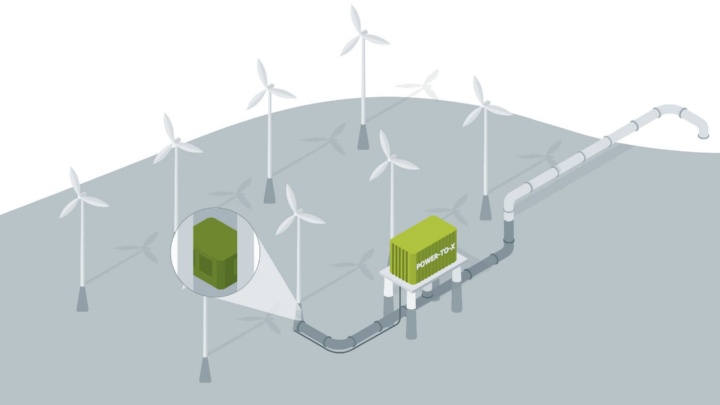Self-sufficient units comprising a wind turbine and an integrated electrolyzer produce green hydrogen on an industrial scale and save the costs of connection to the grid. In this way, they can make a significant contribution to the reduction of greenhouse gas emissions. In a second phase, the green hydrogen can be converted into further synthetic fuels and energy carriers. This vision is now intended to become a reality in the scope of the H2Mare flagship project funded by the German Federal Ministry of Education and Research (BMBF). The Institute of Energy Economics and Rational Energy Use (IER) and the Institute of Industrial Automation and Software Engineering (IAS) at the University of Stuttgart are involved in two subprojects, which are being funded with a total of two million euros.
Prof. Kai Hufendiek, Head of the IER at the University of Stuttgart says: "Liquid fuels that can be directly produced offshore using renewable energy could be an important component for a sustainable, climate-neutral power system, offering the opportunity to install and export such technologies, independent of the power grid. For this to happen, however, it must be possible to operate such systems stably, reliably, and efficiently as energy islands. This requires intelligent algorithms and systems; and it is these that we want to develop." Prof. Michael Weyrich, Head of IAS, adds: “This project enables us to research a new generation of modular process control systems that can communicate with each other. Such decentralized control systems allow the development of a digital twin for different plant configurations that is adaptable, easily expandable, and resilient.”
Molecules instead of electrons
The offshore wind turbines of the future are set to produce molecules instead of electrons: self-sufficient units comprising a wind turbine and an integrated electrolyzer produce green hydrogen on an industrial scale and save the costs of connection to the grid. In this way, they can make a significant contribution to the reduction of greenhouse gas emissions. In the second phase, the green hydrogen can be converted into further synthetic fuels and energy carriers, which offer several advantages in terms of transport and application. Furthermore, H2Mare is investigating further methods for the storage and use of offshore electricity surpluses (offshore power-to-x methods, or PtX for short).
This will involve consideration of the entire value creation chain: from wind energy generation and hydrogen production to the conversion of hydrogen into methane, liquid hydrocarbons, methanol, or ammonia right up to use in industry or the energy sector. As such, various industrial downstream uses and storage options are possible. The goal is a significant cost advantage in the production of large volumes of hydro-gen.
H2Mare comprises the four subprojects OffgridWind, H2Wind, PtX-Wind and TransferWind. The IER and the IAS at the University of Stuttgart are involved in the latter two subprojects:
PtX-Wind: In contrast to pure offshore hydrogen production, the focus here is on conversion to more easily transportable, synthetic energy carriers and fuels, such as methane, methanol, and ammonia. The power-to-X products are produced via high-temperature electrolysis and CO2 extraction from the air or sea. Direct saltwater electrolysis is also being tested.
TransferWind: TransferWind addresses the transfer of knowledge to the public as well as the exchange of expertise across projects. At the same time, it also considers safety and environmental issues as well as infrastructure requirements.
In these subprojects, the IER and IAS are responsible for the development of innovative algorithms for the intelligent operational management of the offshore PtX system and the associated process control technology. The specific challenge here is to link the highly dynamic wind energy production of an offshore wind farm, that is not connected to the grid, to the production of green hydrogen or other synthetic, liquid or gaseous energy carriers in complex process engineering processes in a stable and efficient manner, and to be able to operate them via teleoperation. To do this, suitable intelligent algorithms must be developed that allow reliable predictive operational management of the system. This will initially be validated based on digital twins and using small demonstration facilities.
About the hydrogen-flagship projects from the BMBF
H2Mare is one of three flagship projects being conducted by the German Federal Ministry of Education and Research, which is supporting Germany’s entry into the hydrogen economy with its largest initiative regarding the energy transition to date. The three hydrogen flagship projects H2Giga, H2Mare, and TransHyDE are the result of an ideas competition and represent a central contribution on the part of the BMBF to the implementation of the National Hydrogen Strategy.
They are intended to remove existing hurdles impeding Germany’s entry into a hydrogen economy over the next four years. The goals of the projects are the serial production of large-scale water electrolyzers (H2Giga), the production of hydrogen and downstream products at sea (H2Mare), and the development of technologies for the transport of hydrogen (TransHyDE).
More than 240 partners from science and industry are working together on the three hydrogen flagship projects. In total, the funding will amount up to € 740 million.
The H2Mare project comprises 35 partners and two associated partners. It is scheduled to run for four years, with a total funding of 100 million euros. Siemens Energy is responsible for the project coordination, with the support of institutes from the Fraunhofer Gesellschaft.
Expert Contact:
Prof. Dr. Kai Hufendiek, University of Stuttgart, Institute of Energy Economics and Rational Energy Use (IER), Phone +49 711 685 – 87801, E-Mail
Prof. Dr. Michael Weyrich, University of Stuttgart, Institute of Industrial Automation and Software Engineering (IAS), Phone +49 711 685-67301, E-Mail


